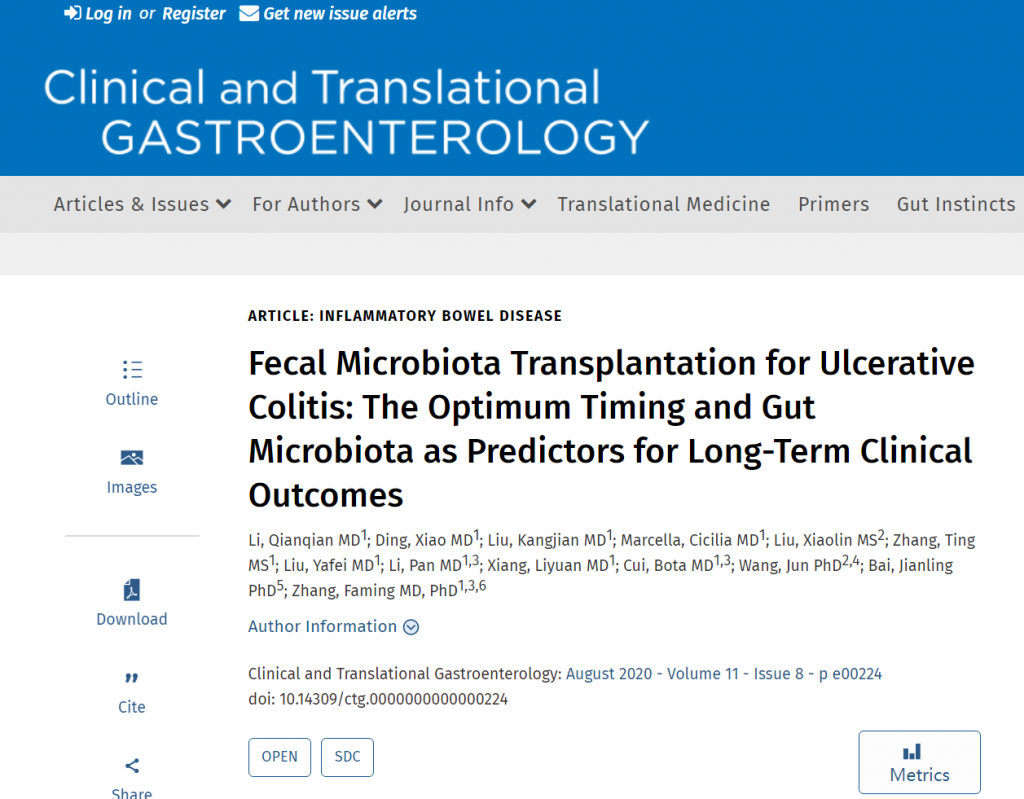张发明团队:粪菌移植治疗溃疡性结肠炎患者第二疗程治疗时机初探

- 纳入122名在第一疗程粪菌移植(FMT)治疗后1个月获得临床应答的溃疡性结肠炎(UC)患者,其疗效中位数维持时间为120天(IQR,45–180),即50%的UC患者在FMT治疗后4个月复发。
- 获益的UC患者应该在首疗程治疗后3个月接受第二疗程FMT从而更好地维持其长期临床疗效。
- 治疗后短期内(5天)Eubacterium、Ruminococcus、Eggerthella和Lactobacillus等菌属的相对丰富度的变化或许可以预测FMT的长期疗效。
- 本项研究将会促进临床医生考虑将FMT的序贯治疗付诸实践作为UC的长期治疗策略。
- 主编推荐语:
越来越多的研究证据表明粪菌移植(FMT)可有效诱导活动期溃疡性结肠炎(UC)患者获得临床缓解,且严重不良反应事件发生率低。但是目前很少有研究报道FMT对于UC应保持怎样的治疗频率从而更好地维持其长期疗效。张发明团队李潘等2018年报道获益于FMT的克罗恩病(CD)患者在首疗程治疗后的3个月应接受第二疗程FMT治疗(热心肠日报关键词检索“张发明”)。《Clinical and Translational Gastroenterology》近日发表了一篇来自张发明团队有关“粪菌移植治疗溃疡性结肠炎患者第二疗程治疗时机”的临床研究。该研究发现获益于FMT的UC患者应该在首疗程后3个月接受第二疗程FMT治疗从而可以更好地维持长期临床疗效。该研究同时还探究了患者治疗前后短期内菌群变化与长期疗效的关系。本研究将会促进临床医生考虑将FMT的序贯治疗付诸实践作为UC的长期治疗策略。
标题:Fecal Microbiota Transplantation for Ulcerative Colitis: The Optimum Timing and Gut Microbiota as Predictors for Long-Term Clinical Outcomes
翻译:粪菌移植对于溃疡性结肠炎:最佳治疗时机以及肠道菌群是否可以作为长期临床结局的预测因子初探。
原文信息和链接
https://journals.lww.com/ctg/Fulltext/2020/08000/Fecal_Microbiota_Transplantation_for_Ulcerative.11.aspx
Journal: Clinical and Translational Gastroenterology
IF: 3.968; doi: 10.14309/ctg.0000000000000224
2020-08-06,article
Abstract:
The previous researches aimed to evaluate the efficacy and safety of fecal microbiota transplantation (FMT) for ulcerative colitis (UC) in a short-term observation. The present study aimed to explore the optimum timing of FMT for maintaining the long-term clinical benefits and to target the gut microbiota which may help to predict the long-term success or failure of FMT in UC. Two hundred and two patients with UC were recruited from November 2012 to September 2018. The primary endpoint of this study was the maintaining time of the first and second courses of FMT. Relapse was defined as partial Mayo score ≥ 2 after achieving clinical remission and an increase of partial Mayo score ≥ 1 after achieving clinical response. The stool samples were analyzed by 16S rRNA gene sequencing. The median maintaining time of the efficacy was 120 days (IQR, 45-180) and 182.5 days (IQR, 105-311.25) from the first course and second course of FMT, respectively. No FMT-related serious adverse events were observed. The differences of the relative abundance in Eggerthella, Lactobacillus and Ruminococcus between pre-FMT and five days post-FMT were remarkably correlated with the long-term clinical remission (p < 0.05). This study demonstrated that UC patients should undergo the second course of FMT within four months after the first course of FMT for maintaining the long-term clinical benefits. The short-term alterations of microbiota after FMT may be conducive to predicting the long-term efficacy of FMT in UC.
First Authors: Qianqian Li, Xiao Ding
Correspondence Authors: Faming Zhang
All Authors: Qianqian Li, Xiao Ding, Kangjian Liu, Cicilia Marcella, Xiaolin Liu, Ting Zhang, Yafei Liu, Pan Li, Liyuan Xiang, Bota Cui, Jun Wang, Jianling Bai, Faming Zhang
本文作者:共同第一作者李倩倩、丁筱,通讯作者张发明


